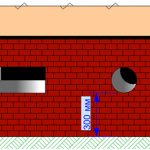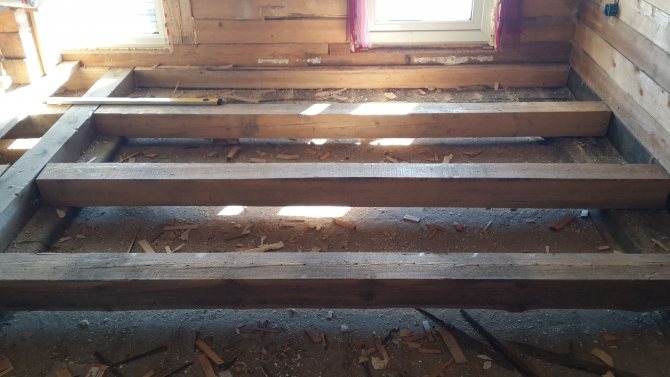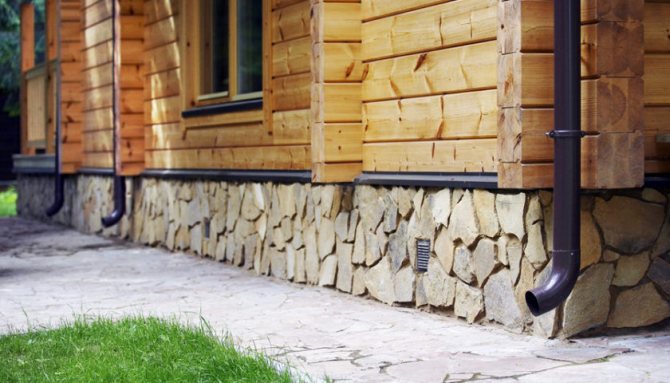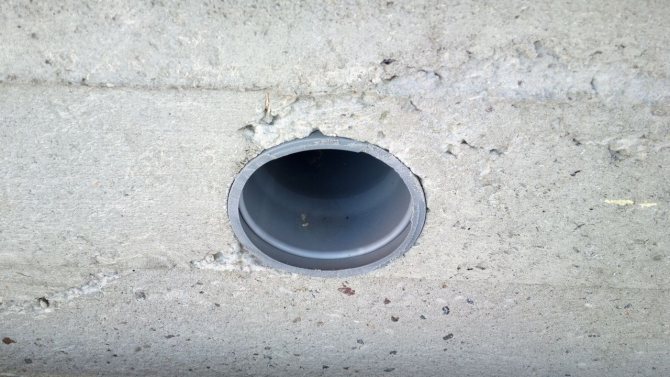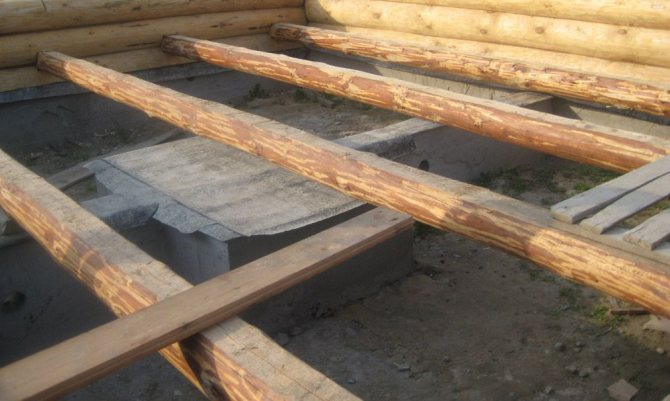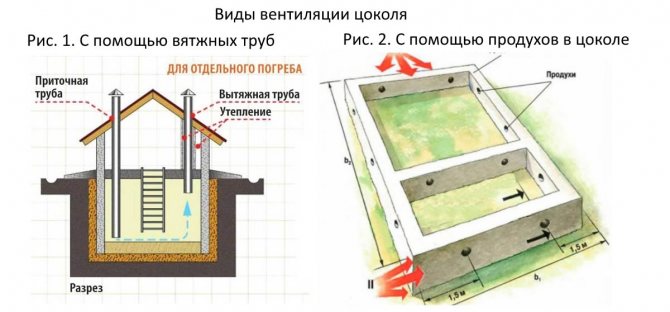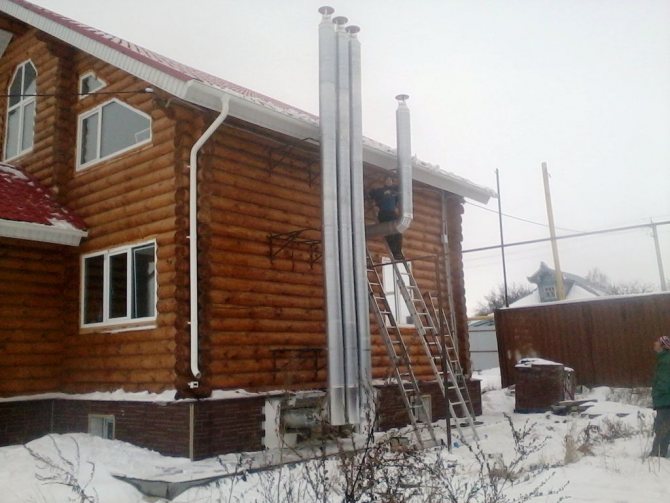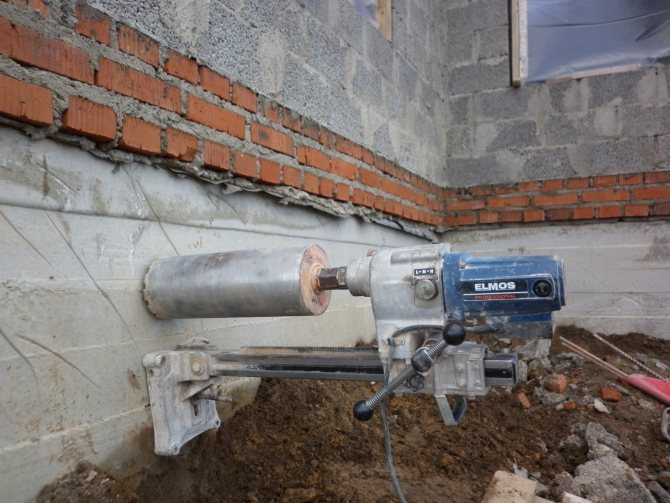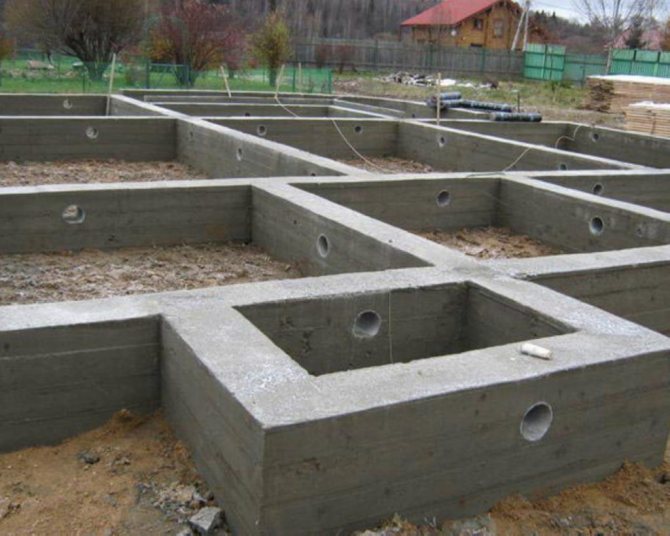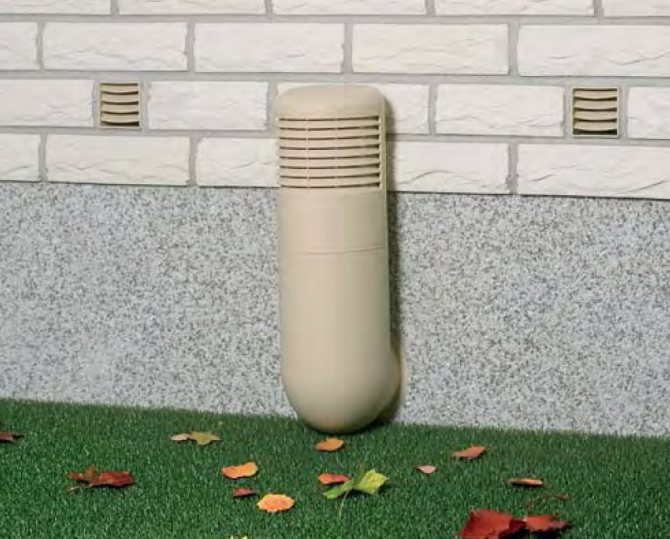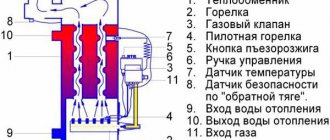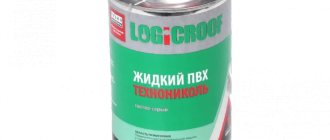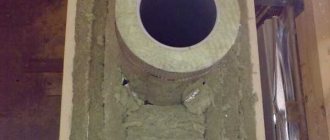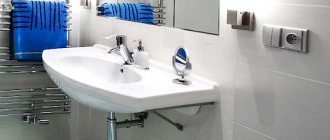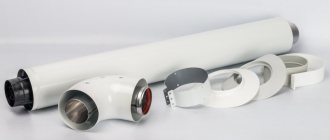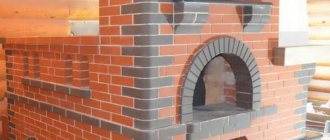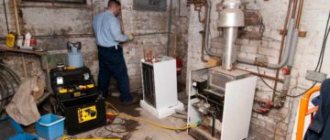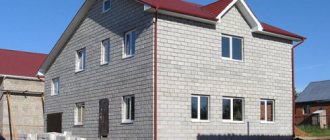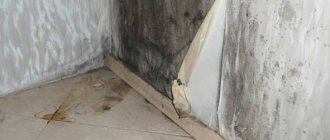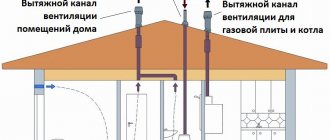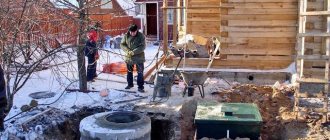Ventilation of the underground in a wooden house is a necessary element of the arrangement. The earth's surface tends to accumulate and release moisture. Cool air from the room also tends to penetrate into the lower part of the building. All this leads to the formation of condensation in a confined space, the release of droplets of moisture on the ceiling and walls.
High humidity adversely affects all structural elements. Mold may develop on wooden parts, and decay processes will accelerate. Stale air with a specific odor will penetrate into the residential part of the house, creating an unfavorable microclimate.
Typical ventilation system diagrams
Air exchange in the basement or interfloor overlap can be arranged according to the following scheme:
- During the construction of the floor, channels are drilled in the beams of the load-bearing frame to ensure air circulation inside the floor. However, such a solution reduces the load-bearing capacity of the floor. Therefore, the practice of arranging ventilation ducts can be abandoned by laying the flooring on a counter lattice, which provides free air exchange in the inner part of the ceiling.
- Supply and exhaust ventilation openings in the floor are drilled along the perimeter of the covering, near the walls, and covered with skirting boards with barred channels. Air circulation is provided due to the through inflow-outflow, which provokes convection in the room.
A ventilation system equipped in this way will protect the floor structure even if vapor-proof materials (linoleum and so on) are used in the interior decoration. In other cases, in addition to ventilation ducts around the perimeter, you can rely on gaps between floorboards, parquet or laminate planks. In addition, such a system will work in tandem with a foundation of any design both in winter and in summer.
Air exchange in exclusively basement floors can be arranged according to a completely different scheme, namely:
- During the construction of the floor, the lower part of the floor frame cladding is not assembled. The lattice of the beams is laid on the supports, followed by the installation of the deck.
- Through ventilation ducts located opposite are equipped in the walls of the foundation. The circulation is provided by blowing caused by natural air convection (wind).
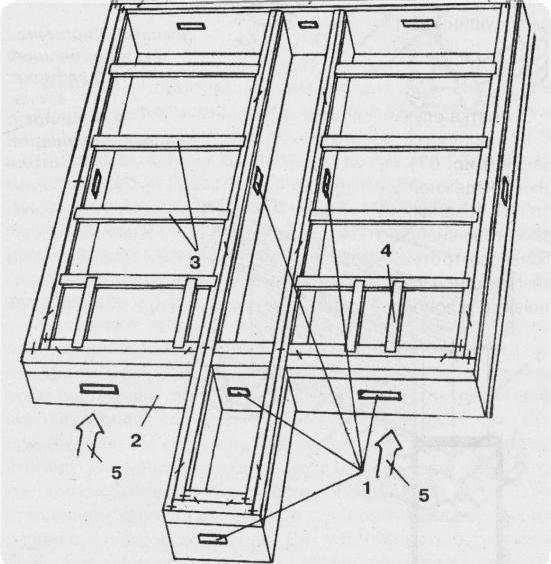
Such ventilation guarantees the safety of the floor, but cannot be used in the case of construction within the boundaries of the basement of the operated premises - basements, baths, underground floors. In this case, the vapor permeability of the finish can be any. Since the air exchange takes place from the subfloor side. But such a system works at full capacity only during the warm season. After all, in winter, the air vents are sealed, and air exchange in the underground stops until summer.
The implementation of each of the above schemes is tied to the type of base structure. Therefore, further in the text, we will consider the nuances of arranging ventilation of the subfloor using the example of foundations of various types
Basement ventilation and foundation design
When deciding how to equip the ventilation of the underground space, it is necessary to take into account not only the dimensions of the basement, but also the type of foundation structure. Moreover, wooden houses are built on three types of foundations, namely:
- On the basis of a strip base, with a foundation supply not only under the load-bearing walls, but also under the interior partitions.
- On the basis of a columnar base with a plinth tape and a girder or monolithic grillage.
- Based on the base plate.
In the first case, floor ventilation in a wooden house is arranged according to a simplified scheme, by means of air vents. During the construction of the basement tape, ventilation ducts (air vents) are integrated into its structure.
In the second case, the air exchange pattern depends on the type of grillage. Beam structures are ventilated according to the classical scheme, by means of air vents. Monolithic grillages require a completely different solution, because it is no longer possible to blow the ceiling through the subfloor. Therefore, such floors are ventilated by means of supply and exhaust openings along the perimeter of the flooring, covered with baseboards with gratings.
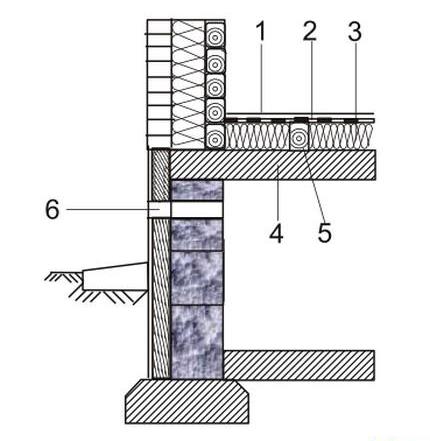

1 - plank flooring; 2 - vapor barrier; 3 - thermal insulation; 4 - floor slab; 5 - wooden logs; 6 - ventilation duct; 7 - wall insulation.
In the third case, the only possible air exchange scheme is to blow the inner space of the floor through the ventilation holes and grilles in the baseboards.
That is, the ventilation of the floor of the house on a strip base or a columnar foundation with a beam grillage is equipped with the help of air vents. Houses on slabs or columnar bases with monolithic grillages require special floors equipped with internal air ducts and a system of supply and exhaust ducts built directly into the ceiling.
At the same time, the performance of each system depends on the dimensions of the ventilation holes - vents or channels in the baseboards. Therefore, further in the text, we will consider the procedure for calculating the dimensions of these structural elements.
Calculation of the dimensions of the ducts
Both air vents and supply and exhaust ducts function under conditions of natural air convection. Therefore, the air exchange rate in such systems cannot be less than 1 m / h. And the upper bar of this indicator depends on the wind speed or the intensity of the home ventilation, prompted by the compressors.
As a result, for simplified calculations of the dimensions of the vents, you should use the recommended ratio between the area of the basement base and the area of the ventilation hole - 400: 1.
That is, with a basement area of 100 square meters, the dimensions of the vents will fit into 0.25 "square". At the same time, according to building rules and regulations, the dimensions of one ventilation duct cannot be less than 0.05 m2.
Guided by similar restrictions, we can determine the number of ventilation ducts, which in this case is 5 pcs.
When solving the problem of full ventilation of a private house, great attention should be paid to the foundation and floor. The potential durability of the house, the ability to avoid general distortions and deformations, depends on how rational the air flow in these structural elements is. Sophisticated floor ventilation in the house
- a guarantee of a quiet residence for many years.
Features of foundation ventilation
In the event that basements are not equipped in the foundation, ventilation consists in the formation in the basement of the system
ducts. But in most houses, basements are a necessary element, therefore, in them, when laying floor ventilation in opposite basement sides, air vents are arranged at different levels. Thus, pressure drops will be ensured, due to which air flows will move in the basement space. Most often, the dimensions of the ducts are 100 × 150 mm.
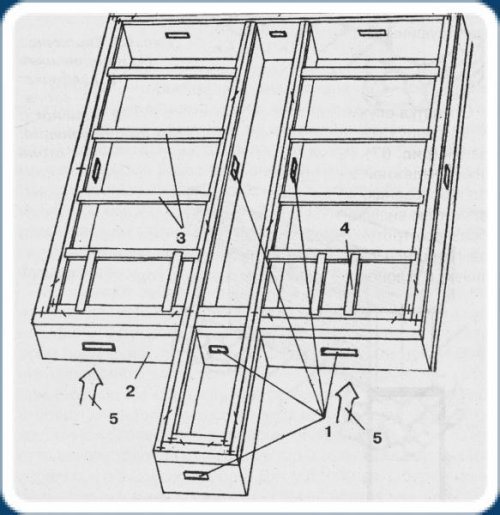

Often, the floors in private houses are insulated over the basement, so the location and amount of ventilation vents will depend on factors such as the topography of the site, structural features of the structure, climatic conditions and the prevailing wind direction.
Constructive need for floor ventilation
Dampness
that occurs during the operation of the house, can cause fungal organisms to multiply in an underground room. Only if an effective floor ventilation system is established in the building, a full-fledged air exchange occurs, eliminating moisture accumulations.
Ventilation grates
According to the well-established method for wooden houses, the issue of ventilation of underground rooms is resolved by installing specialized wall gratings installed above the ventilation holes (or otherwise sockets) in the floor. And there is one trick here: the optimal place for cutting the grating is - joint between two boards
... In this case, the excavation area is minimized, which means that the strength of the floorboards will be fully preserved.
As long as the gratings are not embedded, the air currents in each room are calculated without fail to mark a specific place of their installation. To a greater extent, air movement depends on the presence, location and intensity of the operation of heating devices. The tie-in points of the ventilation grilles must necessarily remain open, that is, free from household items and furniture.
Ventilation skirting boards
In addition to using specialized grilles, floor ventilation in a private house
can be reinforced with ventilation skirting boards equipped with openings that are designed to ensure uninterrupted air circulation. As a rule, such holes have a diameter of no more than 10-15 mm. These skirting boards must be mounted at opposite walls of the room along their entire length.
In some cases, experts recommend installing a ventilation skirting board only along one of the walls
... The floor against the wall opposite will be tightly adjacent to the partition, and full air exchange for floor ventilation will be provided with the help of a ventilation pipe. The pipe can be brought outside the house at about a one and a half meter level, in this case there will be a drop in atmospheric pressure, which contributes to an increase in the intensity of air flow.
Video review - floor ventilation using modern technologies
The underground space of a private house must be ventilated. This is especially true for houses on strip foundations. In modern cottage construction, the option of a strip foundation with an open subfloor is practically not used. Most often, the space of the subfloor is covered with sand or expanded clay. Ventilation of the floor of the house must be equipped in accordance with the existing SNiP.
Preparatory stage
So, before starting the construction of the basement, it is necessary to determine the following nuances:
- The area of the vents in the basement - everything is quite simple here, the total square is divided by 400 - the resulting value will be a guideline. For example, with an area of 100 square meters, all airflows should total 0.25 m2. If the holes are made from a plastic pipe with a diameter of 110 mm, then there should be 25 holes.
- The location of the holes is another important factor, there are several basic requirements. They should be located at the maximum height from the ground, but this distance should not be less than 30 cm. All vents should be located in one line, both in the external and internal partitions.
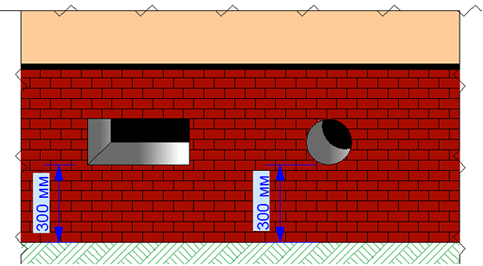

In no case should the vents be placed below
- The outer holes should be located no further than 90 cm from the edge, otherwise spaces will form inside in which air will stagnate.
- It is best to make a layout plan in advance and stock up on the necessary materials.
Advice! Do not make too large holes, as the space around them will have to be additionally reinforced, and this is a large amount of additional work.
A plan will make your job much easier.
Next, you should prepare the necessary materials and equipment:
- You can make square windows, after knocking down the patterns from the tree, its length should be equal to the width of the foundation. This method has a big drawback - after the concrete has hardened, it is very, very difficult to extract wood from it. Therefore, it is better to use another option.
- Recently, pipes are most often used - plastic or asbestos-cement. The technology of their preparation is quite simple - pieces are cut to the width of the foundation, after which they are folded and await concrete work.
- And the most time-consuming method is making holes in a solid foundation using special equipment. The cost of the work is very high, most often this is done when it is necessary to make additional airflows in an already standing building.
- And one more important factor - you should prepare nets or decorative grilles for air vents in advance, otherwise rodents and other small animals can enter your basement. In addition, closed holes look much more attractive than holes.
The grille does not impede the penetration of air, but reliably protects against insects and rodents
Types of ventilation of the subfloor of the house
There are two types of ventilation in the subfloor of the house: natural and forced.
Natural floor ventilation in a wooden house is the cheapest method. Equipped with air vents. If the house is built on a hillock, this is often enough. However, how to ventilate the subfloor of a low-lying house? The ducts are attached to the windward side.
Forced ventilation in the basement of a private house is provided by installing several fans.
Requirements for ventilation of the subfloor of the house
As a rule, when erecting houses on a strip foundation, the diameter of the air vents is made too small, therefore, high-quality ventilation in the underground of a private house does not work. So, to provide ventilation in the subfield of a house with an area of 100 sq. meters, it is necessary to make twenty-five round-shaped blows with a diameter of 10 cm each. Most often, the owners are satisfied with only 5 - 7 holes, therefore, before making the ventilation of the subfloor, the area of the vents should be calculated.
According to the requirements of the Building Norms and Rules for residential buildings, in the underground technical and basements that are not equipped with ventilation, airflows with an area of 1 \ 400 of the area of the room should be made.
You need to distribute the holes evenly around the entire perimeter of the building. The area of each hole is from 50 sq. centimeters. If the area is unfavorable in terms of the level of radon in soils, the area of all airflows should be 1 \ 100 of the area of the room. According to international building codes, for ventilation of the subfloor of the house, the area of the holes should be calculated on the basis of 90 sq. centimeters by 14 sq. meters of the foundation area. From the corner of the foundation to the vents, there should be no more than 90 centimeters, otherwise there will be windproof corners in the subfield.
When you can do without airflow
According to international building codes, you can not do it on purpose, if.
Ventilation of the underground and floor in a wooden house is a prerequisite for protecting wooden structures from the appearance of mold, rot and fungi.
The habitat of putrefactive bacteria and fungi is high humidity at above-zero temperatures, and in a confined space, if you do not organize air ventilation in the basement of the foundation, moisture evaporating from the soil will concentrate on wooden beams and subfloor. The presence of moisture in the underground, the development of fungi and rot will lead to the destruction of wooden structures.
A wooden house made of timber, glued beams and logs in the classic version is erected on a strip concrete foundation, which allows the wooden structure of the building to be separated from the ground.
The space between the ground level and the subfloor with floor joists is underground.The construction of the finished floor with insulation is mounted on the floor beams. The soil under the floor creates dampness from evaporated moisture, which settles in the form of steam on wooden structures, creating conditions for the growth of bacteria, mold and mildew.
Natural ventilation is laid at the stage of foundation construction
To preserve the floor in a wooden house at the design stage, a natural ventilation of the underground space is provided and is implemented during the construction of the foundation.
The traditional base for a wooden house is a strip foundation or basement cast from concrete, the same strip foundation, erected on a concrete slab with a strip wall height of 2 m.
Ventilation structure
When designing a strip foundation, it is necessary to take into account that heat losses from the base of the house with mistakes in the design and violations of the operation of the underground can reach 30% of the total heat losses. To prevent this, it is important to know:
The construction of a shallow strip foundation under a wooden house is wrong. The ground under the house in winter will freeze through, and in the summer, the underground space narrowed in height and the close arrangement of the beams from the ground will not allow effective ventilation of the wooden floor structures.
Shallow deepening of the foundation will not allow high-quality natural ventilation of the underground, and in winter a layer of frost will form on the wooden structures, which will turn into water in the spring.
Ventilation holes are placed before the concrete is poured
When erecting a strip foundation, the basement part above the ground is half the size of the underground part of the foundation strip and is 500 - 600 mm. Accordingly, the underground part is deepened for more than a meter.
The slab under the tape and the tape from the outside along the perimeter is insulated with Penoplex boards with a thickness of at least 50 mm. This insulation will protect the freezing of the ground in the underground and the foundation itself.
In the basement part of the foundation strip, before pouring the concrete, ventilation holes are provided, at the rate of 3 pm of the foundation strip, one hole, 120 by 120 mm or 150 mm 2.
For high-quality ventilation, holes are made on opposite walls opposite each other in order to create a through air flow. If a main wall is provided in the house, under which a foundation tape is being erected, then ventilation holes are also arranged in it, in one axis with the outer ones.
The location of the ventilation holes is in the upper part of the plinth, closer to the floor joists.
How to make vents
Air vents are formed at the stage of making the foundation. If we are talking about a strip monolithic foundation, then the embedded parts are laid and fixed after installing the reinforcing frame. To organize round ducts, plastic or asbestos-cement pipes are laid. Their edges are brought out flush with the outer edge of the formwork, and are well fixed. If plastic pipes are used, sand is poured into them, the edges are closed with plugs. This is necessary so that the mass of concrete does not flatten them when pouring. These mortgages are not removed after formwork.
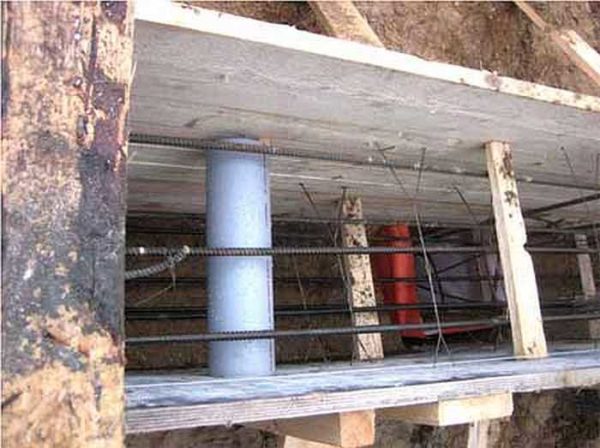

Installed plastic pipes for vents in the plinth
Rectangular vents are formed from boards, knocking down a box of the required size. It is also installed in the formwork, but after the concrete has set, the wood is removed.
If the basement is built of bricks, you can periodically trim the bricks or put a half instead of a whole. In the plinths of concrete blocks, they take several pieces with two large holes, make them through. Set instead of one of the "normal" ones. If the foundation and plinth are built of reinforced concrete blocks, air vents are made at the joints.
Related article: Curtains for a hall with a balcony (photo)
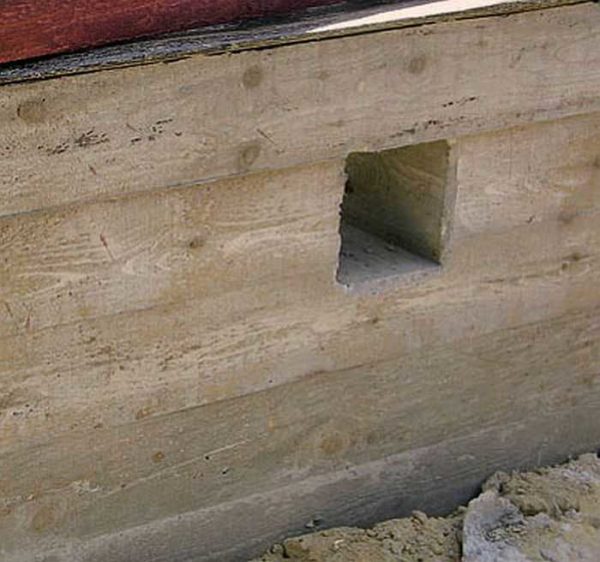

The formwork was removed
Vents are also organized approximately in columnar, pile (screw, bored, TISE) foundations. When the gaps between the supports are closed with the selected material, the required number of holes is left, the total area of which is 1/400 of the subfloor area.
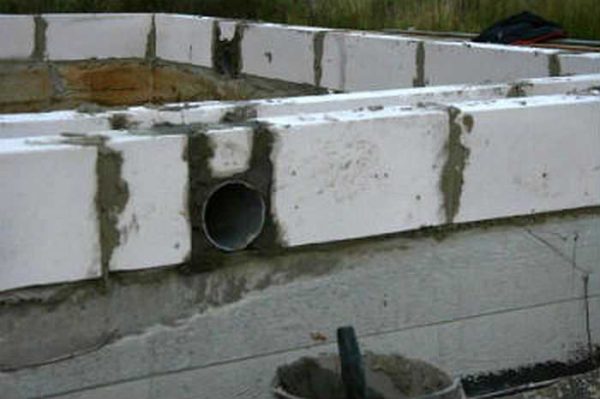

So you can insert the vent pipe into the base of the blocks
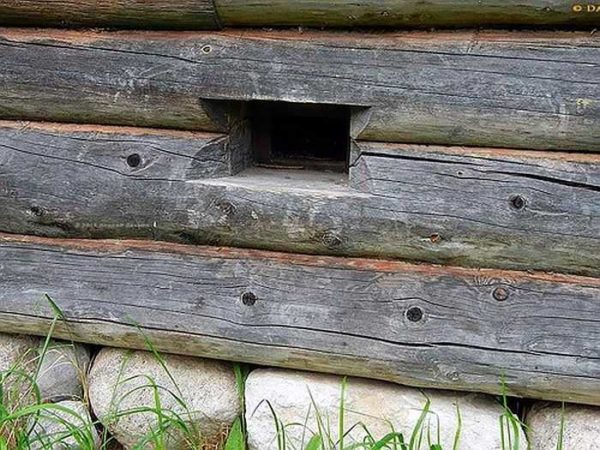

An example of the formation of a vent in a wooden house from a log
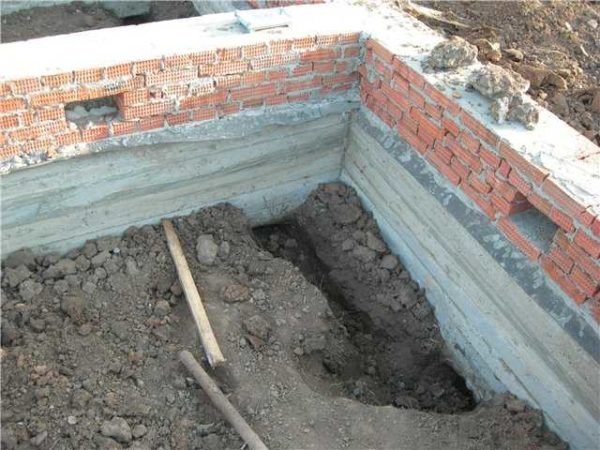

Air vents in a brick plinth
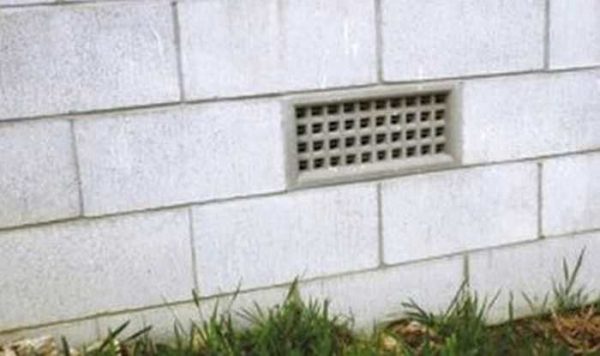

Close with fine mesh
Features of the device
Before the construction of the foundation, the plant soil from the area under the house is completely removed, and the soil on the site is compacted. It is desirable that the distance from the ground to the beams under the floor be sufficient for possible inspection of the wooden floor structures and the application of an antiseptic solution.
The presence of a vegetation layer in the underground contributes to additional humidification of the air and complicates high-quality ventilation of the underground space.
A bar or a calibrated log of the first crown with beams and a subfloor, before laying on the foundation, is covered with an antiseptic composition that protects the wood from moisture penetration.
Lay insulation on the subfloor
Insulation is laid between the floor beams on the subfloor, and a final floor covering is assembled on the beams.
To prevent moisture from getting into the insulation, the beams with the insulation are covered with a waterproofing film from the side of the underground, and a vapor barrier film from the side of the room. For ventilation in the floor, a gap of 3 - 5 cm is maintained between the finished floor and the insulation, through which air circulates, entering the room through the holes in the baseboard.
Ventilation of the insulation and the finished floor is carried out with room air, which does not allow moisture to condense on the surface of the vapor barrier film.
Air vents should be open during the warm season.
In the summer, the air vents in the foundation are constantly open, since the concentration of groundwater is high, the evaporation of moisture is intense, and in the winter, the evaporation rate decreases, and so that the ground in the underground does not freeze through, the air vents are closed.
In areas where the temperature does not drop below minus 15 - 20 ° C in winter, the air vents are opened for ventilation 2 times a month, and in the northern regions at temperatures below minus 25 ° C, they should not be opened.
To prevent rodents from entering the underground and damage the tree, the air vents are covered with a metal grate for a warm period. The location of ventilation openings from the corners of the building should be at a distance of no more than 1 m for high-quality ventilation of the entire underground.
Cover the openings with grating to prevent mice and debris from entering the air vents.
Once every 4 - 5 years, an antiseptic solution is applied to wooden structures underground, and every year the vegetation under the house and in front of the ventilation holes is removed.
To enhance the natural ventilation of the underground, exhaust pipes are mounted to the air vents to create air draft, this is important for buildings located in low-lying areas, where the movement of air masses is not intensive.
When erecting a building on the basement floor, there is no need for ventilation of the beams and the subfloor, since the basement floor is made of a concrete slab, and the floor itself is heated. But in the basement there are rooms used for storing vegetables and fruits, in which there is high humidity. For information on how the air is made, see this video:
They are equipped with forced ventilation by means of a fan, exhaust and supply pipes, the humidity and temperature in the room are controlled by sensors and maintained in optimal mode.
Forced ventilation is supported by fans
Ventilation of the floor in a private house of a large area is arranged forcibly, since in the underground space through vents over a large area, a through air flow is not created.
To perform forced ventilation, a system of fans with exhaust and supply pipes is used. When calculating the cross-section of the ventilation pipes and the power of the fans, the volume of the underground and design features are taken into account in order to create air flows that cover all areas of the wooden structure.
Forced ventilation of the underground is usually combined with forced ventilation of the premises in the house.
The ventilation works in automatic mode, which allows you to maintain a certain air humidity in the rooms and prevent an increased concentration of moisture and the formation of mold in poorly ventilated places. For information on how to mount flow ventilation, see this video:
Forced ventilation, operating in automatic mode, allows you to qualitatively control the state of humidity in rooms, including underground, and prevent the appearance of fungi and putrefactive bacteria on wooden structures.
- Why does the fungus appear in the house?
- Means for combating fungus
- Soda is an effective and simple remedy against fungus
- Fungus destruction: step by step instructions
- Recommendations for the treatment of surfaces affected by fungus
Various fungi and molds have accompanied humanity throughout its history. Mold appeared on the planet much earlier than humans. It was only relatively recently that fungi began to be treated as a big problem. Many people are used to the characteristic smell and do not pay attention to it. For some reason, rooms with black fungi do not shock people, and the greenery of the basement in a summer cottage or personal plot does not interfere with storing food supplies there.
Mold can occur due to insufficient floor ventilation.
However, then people wonder why they suddenly developed an allergy, it became difficult for them to breathe, or a perfectly built house suddenly began to rot. Of course, everything can be attributed to low-quality materials or something else, without paying attention to the main reason. When fungal spores enter your home, they can begin to multiply actively in a humid environment that is comfortable for them. It is impossible to remove the fungus with regular cleaning. However, it can be completely destroyed using special means, preventing its reoccurrence. Before you destroy the fungus, you need to understand the reasons for its appearance in order to prevent this from happening in the future.
Purpose of air vents in the basement
Air vents for the natural access of air to the basement help prevent dampness due to which mildew and mildew develop. But this ventilation is not always effective. It often happens that there are holes, but the dampness does not disappear.
This is due to a violation of the temperature and humidity regime in the basement. In summer, the air inside the basement is cooler than outside. Warm air masses penetrate from the street, and the moisture contained in it condenses, forming water droplets. They settle, evaporate and dampness occurs.
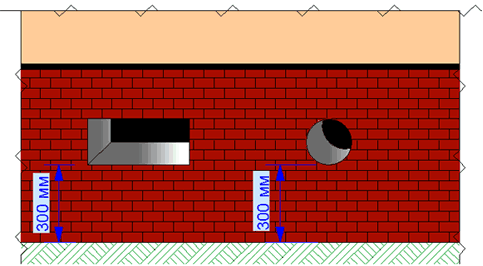

Why does the fungus appear in the house?
Fungus may be due to improper condensation and condensation on the floor.
To permanently destroy the fungus, you first need to find out the reasons for its appearance in the house. Microscopic spores are present everywhere, and as soon as they get into a favorable environment, they begin to grow. The most common causes of fungus are lack of ventilation and high humidity. Mold is a simple fungus that, in turn, loves rooms with poor ventilation and high humidity. Damp apartments on the ground floor, houses, cultivation of many tropical indoor plants in a small room, unreasonable use of humidifiers - all this can lead to the appearance and spread of fungus.
Among modern finishing and building materials, there are almost no ones that would not be affected by the fungus.It very often appears in toilets, bathrooms, on air conditioning filters. It can also be found in the refrigerator or washing machine, on wallpaper, books, under the floor.
The first sign of a fungus is a specific pungent and raw odor. Then you can see spots of black, whitish or gray color.
If a fungus has appeared in your house, then before starting to fight it, it is imperative to solve the problem of poor ventilation and high humidity, otherwise it will appear again and again.
Mold can be removed with soapy water and sandpaper.
The solution to the problem of getting rid of the fungus under the floor must be approached in a comprehensive manner. It is not enough just to scrape off and wash off the growths of the fungus, it is imperative to create such a microclimate in the house in which a new fungus will never appear. The main areas of work to combat fungus in the house are as follows:
- the floor, ceiling and walls are mechanically cleaned of mold;
- all surfaces are treated with an antifungal agent;
- things deeply damaged by mold are thrown away;
- constant good ventilation is being established in the room so that the air does not stagnate;
- the humidity in the room decreases. All sources of high humidity are found and eliminated.
Back to the table of contents
Means for combating fungus
The fungus can be removed with the help of special antiseptic preparations, which are presented in a large assortment on the shelves of building materials stores. It must be remembered that any chemicals used to remove fungus are poisonous. Therefore, it is necessary to work with them extremely carefully. Before starting to use, be sure to read the instructions. It is also important to understand that porous materials, such as upholstered furniture and wallpaper, are sometimes very strongly affected by the fungus in depth, it is impossible to clean them, and therefore you have to get rid of them.
After removing the mold, the floor must be impregnated with varnish or primer.
The best and most proven remedy for combating fungus over the years is a special antiseptic primer. You can buy such a primer at building materials stores. It performs 2 important functions: it helps to defeat the fungus and protects against its appearance in the future.
The antiseptic primer is easy to use and usually does not even need to be added with water. If the primer is undiluted, be sure to follow the instructions to get the right formulation for effective fungal control.
Before applying the primer, the affected surface is cleaned. If the mold has penetrated deeply into the plastered wall, it is necessary to clean everything to a clean layer. Sometimes you have to reach a brick or concrete slab. The primer is applied evenly on a dry surface using a paint brush. After the primer is dry, wallpaper or paint can be applied.
Home remedies can also be helpful in fighting fungus. They are not as effective as antiseptic primers, but they are also less toxic. Almost all types of mold can be defeated with ordinary bleach. The active ingredient in the bleach, sodium hypochlorite, kills the fungus and its spores. With the help of bleach, you can clean the floor, glass, tiles in the bathroom, but some things under the influence of bleach discolor and deteriorate.
If groundwater seeps into the basement, backfill the floor with stones and sand.
In addition, bleaches give off toxic and harsh fumes and are corrosive to the skin of the hands. Before proceeding to remove fungus with bleach, be sure to make sure the area is well ventilated. Be sure to wear rubber gloves to protect your hands. The affected area should be treated with a mixture of 1 part bleach to 10 parts water.
Ordinary vinegar can also kill many common types of fungus.It has a characteristic odor, but does not emit harmful fumes such as bleach. To get rid of the fungus, vinegar must be applied to the affected surfaces with a spray bottle or wiped with a damp cloth. After an hour, the surfaces are washed with water, and the room is ventilated. To prevent the appearance of fungus, vinegar should be sprayed on problem areas every week.
Ammonia is also used to kill fungus. Like bleach, ammonia can easily remove mold on non-porous hard surfaces such as glass or tile, but it is not suitable for removing fungus from porous materials. To destroy the fungus with ammonia, it must be mixed in equal parts with water and sprayed onto the infected area. The solution is left on the surface for several hours, after which it is washed.
The characteristic pungent smell of alcohol can cause a sore throat and headache. Do not mix ammonia with bleach, because this produces poisonous gas.
Back to the table of contents
Expert advice
Ventilation of the strip foundation is an extremely important aspect that must be taken into account when building a private house. To avoid corrosion of the materials of the foundation and the basement itself, it is better to refrain from blocking the air in the ducts, even at low temperatures. The soil itself will not allow the room to freeze, and as an auxiliary option, good insulation can help. If the basement floor was planned as a storage room, the question of a comfortable temperature is secondary. The main thing is to adjust the ventilation system so that dampness does not appear. It is very difficult to get rid of it later, but it is very easy to breed mold bacteria in the room.
Therefore, even if there is some kind of home-made system of dampers in the air ducts, it is worth making sure that the room is first of all well ventilated in winter.
Soda is an effective and simple remedy against fungus
One way to avoid under-floor fungus is to install a heating system.
Baking soda is also very effective against fungus. It attacks mold and is known to be a safe and natural household cleaner. Unlike other products containing harsh chemicals, baking soda will not harm people or animals. A teaspoon of baking soda must be dissolved in a glass of water and sprayed with these solutions on the affected surfaces. You can simply soak a sponge in a baking soda solution and wipe down things and surfaces. If not completely rinsed off the surface, baking soda will provide effective protection against the reappearance of hazardous formations.
You can get rid of the fungus using a variety of means, but this is only half of the solution to the problem. The other half is to keep the area dry and ventilate regularly to prevent the fungus from reoccurring.
Any work related to the fight against fungus can harm your health. Mold spores can enter the skin and respiratory system. This is a very serious problem that can lead to various health problems.

